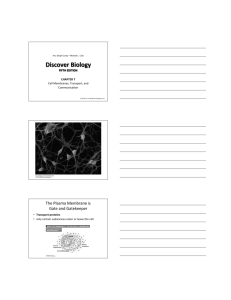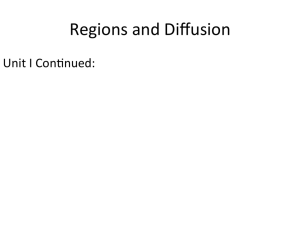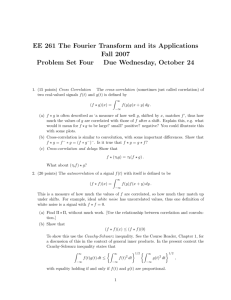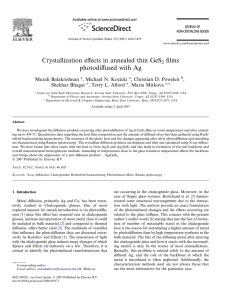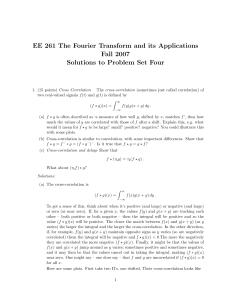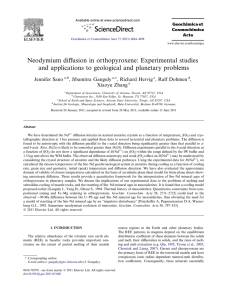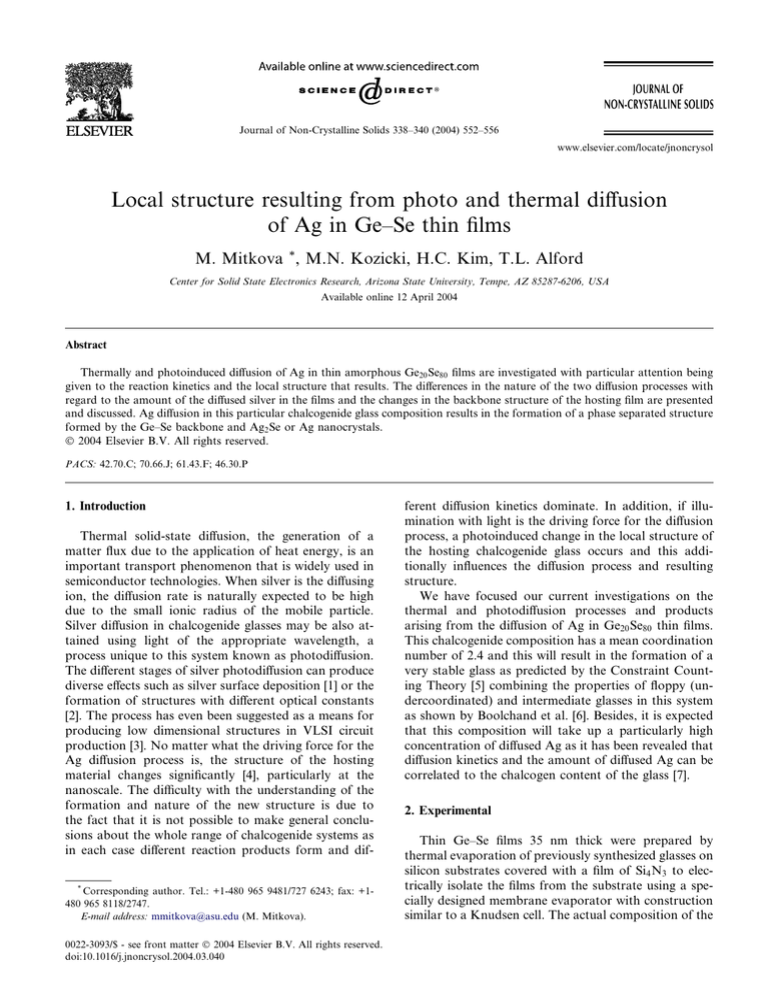
Journal of Non-Crystalline Solids 338–340 (2004) 552–556
www.elsevier.com/locate/jnoncrysol
Local structure resulting from photo and thermal diffusion
of Ag in Ge–Se thin films
M. Mitkova *, M.N. Kozicki, H.C. Kim, T.L. Alford
Center for Solid State Electronics Research, Arizona State University, Tempe, AZ 85287-6206, USA
Available online 12 April 2004
Abstract
Thermally and photoinduced diffusion of Ag in thin amorphous Ge20 Se80 films are investigated with particular attention being
given to the reaction kinetics and the local structure that results. The differences in the nature of the two diffusion processes with
regard to the amount of the diffused silver in the films and the changes in the backbone structure of the hosting film are presented
and discussed. Ag diffusion in this particular chalcogenide glass composition results in the formation of a phase separated structure
formed by the Ge–Se backbone and Ag2 Se or Ag nanocrystals.
Ó 2004 Elsevier B.V. All rights reserved.
PACS: 42.70.C; 70.66.J; 61.43.F; 46.30.P
1. Introduction
Thermal solid-state diffusion, the generation of a
matter flux due to the application of heat energy, is an
important transport phenomenon that is widely used in
semiconductor technologies. When silver is the diffusing
ion, the diffusion rate is naturally expected to be high
due to the small ionic radius of the mobile particle.
Silver diffusion in chalcogenide glasses may be also attained using light of the appropriate wavelength, a
process unique to this system known as photodiffusion.
The different stages of silver photodiffusion can produce
diverse effects such as silver surface deposition [1] or the
formation of structures with different optical constants
[2]. The process has even been suggested as a means for
producing low dimensional structures in VLSI circuit
production [3]. No matter what the driving force for the
Ag diffusion process is, the structure of the hosting
material changes significantly [4], particularly at the
nanoscale. The difficulty with the understanding of the
formation and nature of the new structure is due to
the fact that it is not possible to make general conclusions about the whole range of chalcogenide systems as
in each case different reaction products form and dif*
Corresponding author. Tel.: +1-480 965 9481/727 6243; fax: +1480 965 8118/2747.
E-mail address: mmitkova@asu.edu (M. Mitkova).
0022-3093/$ - see front matter Ó 2004 Elsevier B.V. All rights reserved.
doi:10.1016/j.jnoncrysol.2004.03.040
ferent diffusion kinetics dominate. In addition, if illumination with light is the driving force for the diffusion
process, a photoinduced change in the local structure of
the hosting chalcogenide glass occurs and this additionally influences the diffusion process and resulting
structure.
We have focused our current investigations on the
thermal and photodiffusion processes and products
arising from the diffusion of Ag in Ge20 Se80 thin films.
This chalcogenide composition has a mean coordination
number of 2.4 and this will result in the formation of a
very stable glass as predicted by the Constraint Counting Theory [5] combining the properties of floppy (undercoordinated) and intermediate glasses in this system
as shown by Boolchand et al. [6]. Besides, it is expected
that this composition will take up a particularly high
concentration of diffused Ag as it has been revealed that
diffusion kinetics and the amount of diffused Ag can be
correlated to the chalcogen content of the glass [7].
2. Experimental
Thin Ge–Se films 35 nm thick were prepared by
thermal evaporation of previously synthesized glasses on
silicon substrates covered with a film of Si4 N3 to electrically isolate the films from the substrate using a specially designed membrane evaporator with construction
similar to a Knudsen cell. The actual composition of the
M. Mitkova et al. / Journal of Non-Crystalline Solids 338–340 (2004) 552–556
mally induced diffusion at a treatment shorter than a
minute, no observable silver diffusion into the films occurs. This ‘induction period’ effect is common for thermal diffusion and has been reported in other similar
systems [9]. More interestingly, in the case of photodiffusion no induction period has been found and the results also show that the diffusion rate and the quantity
of silver at saturation of the films are higher. Fig. 1
shows the overall change in the amount of the diffused
silver with time. The kinetics curves illustrate that saturation after thermal diffusion occurs when the concentration of Ag introduced into the chalcogenide
matrix reaches 43%, while for photodiffusion the
amount of the diffused silver is 47.3 at.% (for comparison, in bulk material one can introduce an maximum of
33 at.% silver [10]).
The Raman analysis gives a clear indication of the
different nature when the diffusion process is driven by
heat or by light. For thermal treatment the presence of
Ge–Se corner sharing tetrahedra at 194 cm1 are seen to
dominate (Fig. 2), as expected for Ge20 Se80 backbone
[11]. The films were placed in a heating camera, so that
we lost part of the signal due to difficulties in focusing of
the laser beam, which results in a poor signal to noise
ratio. The noisy spectra were therefore numerically
smoothed to enable extraction of meaningful information. Although the selenium concentration is high and
the initial network is expected to exhibit high flexibility
having a ‘non-stressed rigid’ structure [6], the peaks
seem to be smeared, suggesting a high degree of disorder
[12] due to strain that occurs because of the differences
of thermal expansion coefficients between the film and
the substrate. With development of the diffusion process
no changes in the position of the Raman modes occur
i.e. no modification in the original configuration of the
backbone structure of the chalcogenide glass takes
place. However fitting the spectra shows systematic
50
Amount of diffused Ag(at.%)
deposited films as determined by Rutherford backscattering spectrometry (RBS) was within ±2.5 at.% of the
initial source composition. Following deposition of the
chalcogenide, a 20-nm silver film was evaporated on top
and this sandwich structure was either subsequently
thermally treated or illuminated with light. The thermal
treatments were performed at 120 and 200 °C in repeated blocks of 10 min up to a maximum of 5 h in
nitrogen atmosphere. The optically treated samples were
illuminated with 436 nm light, which is above the optical
gap of the chalcogenide, at room temperature for various times using the light source of a Karl Suss MJB-3
contact aligner with an optical power density of 6.5 mW/
cm2 . The typical illumination time was 10 min. The
residual silver on the surface of the sandwich structure
was dissolved in 1 mol solution of Fe(NO3 )3 .
The composition of the resulting films before and after
the diffusion process was studied using RBS analysis,
performed with 2 MeV 4 Heþ with the beam at normal
incidence to the sample and a backscattering angle of
65°. As the samples were quite beam sensitive, a reduced
charge of around 0.25 lC/mm2 was used. Experimental
RBS curves were fitted with those obtained by numerical
calculation using the ‘RUMP’ software package [8]. The
chemical composition of the layer and the corresponding
number of atoms of silver were used as fitting parameters. The shape and position of the RBS yield energy
profiles have Gaussian form which is the result of the
convolution of the normalized Ag concentration distribution and another Gaussian function which models the
broadening in the RBS spectra due to the energy resolution of the detector and associated electronics. Because
the signals from Ge and Se are very close to each other, a
shoulder forms in the spectra but each of the individual
signals is Gaussian in character.
The phases formed in the films were characterized by
means of an X-ray diffraction (XRD) method performed
by CuKa radiation in the 2-theta range from 23° to 100°
at a step size of 0.05°.
Raman spectra were obtained to provide information
on the short and medium range order occurring in the
films after the diffusion processes. These investigations
were performed in the micro-Raman mode with the
following conditions: 15 s at 15 accumulations by illumination with 1.5 mW of light power on sample with
647.1 nm wavelength of a Krþ ion laser. In situ measurements at elevated temperatures placing the films in a
special thermal camera purged with nitrogen were also
performed. The experimental curves were fitted with
Labcalc software package.
The amount of diffused silver was established using
RBS analysis and the results show that in case of ther-
Photo diffusion
40
Thermal diffusion
30
20
10
0
3. Results
553
0
5
10
15
20
25
Time (min)
Fig. 1. Amount of diffused silver in Ge20 Se80 films: (a) due to photodiffusion; (b) due to thermal diffusion.
554
M. Mitkova et al. / Journal of Non-Crystalline Solids 338–340 (2004) 552–556
10
(a)
virgin film
65.0
Normalized intensity(a.u.)
Counts (arb. units)
65.5
(b)
64.5
o
HT@120 C, 10 min
64.0
63.5
(c)
o
HT@200 C, 10 min
63.0
50
100
150
200
250
300
8
6
+
4
++
Initial film
* *
*
*
HT@200°C
^ *++*
*
*
2
20
30
40
50
60
70
80
90
100
-1
Raman shift (cm )
2 Theta (deg.)
Fig. 2. Raman spectra of Ge20 Se80 film: (a) virgin film, (b) film after
thermal treatment at 120 °C for 10 min, and (c) film after thermal
treatment at 200 °C for 10 min.
Fig. 4. XRD pattern of thermally diffused Ge20 Se80 films: (a) virgin
film, (b) film after thermal diffusion at 200 °C for 10 min: * denotes
peaks of Ag, + denotes peaks of orthorhombic Ag2 Se, and ^ are peaks
of cubic Ag2 Se.
reduction in the scattering strength of the Se chain mode
at 260 cm1 (CM) with the annealing time.
In the case of photodiffusion, drastic changes in the
structure of the hosting material take place when saturation is reached as shown in Fig. 3. Prior to diffusion,
the hosting material exhibits modes of Ge–Se cornersharing tetrahedra at 194 cm1 , low scattering from edge
sharing tetrahedra at 221 cm1 , and Se chains at 260
cm1 (stretching mode) and 150 cm1 (bending mode).
However, after the diffusion process is complete, we see
at 180 cm1 the mode of the ethane-like molecule
Ge2 Se6 and at 203 cm1 the mode of the GeSe4 tetrahedron.
The XRD investigation shows that prior to any
treatment, the films consist of micro-crystalline Ag with
2-theta peaks at 38.12°, 44.30°, 81.54° and 97.89°
(JCPDS card #87-2871) and an underlying amorphous
matrix of Ge–Se glass, as shown in Fig. 4. Following
thermal diffusion at 200 °C to completion, features of
orthorhombic Ag2 Se with peaks at two theta 26.97°,
33.54°, 40.41° – JCPDS card # 06-0501; 28.83 – JCPDS
card # 25-0766; and 43.43° JCPDS card # 20-1063
emerge together with peak of cubic Ag2 Se at 35.89° –
JCPDS card # 27-0619 and silver. From the XRD data,
one can also see that the Ge–Se backbone remains
amorphous after the thermal anneal.
Counts (arb. units)
1.6
1.2
0.8
Ge 20 Se80
b)
(Ge 20 Se80 ) 53 Ag 47
c)
Ag 2Se
0.0
100
200
We now discuss the most important results of our
work regarding how and in what form silver incorporates into the Ge20 Se80 films and show in what manner
the resulting structure depends upon the way in which
the diffusion process is performed. If we assume that the
mean coordination of Ag with Se is 3 we can use the
equation proposed in Ref. [10] to estimate the composition of the glasses after Ag is introduced:
ðGex Se1x Þ1y Agy ¼ ð3y=2ÞðAg2=3 Se2=3 Þ
a)
0.4
4. Discussion
300
400
-1
Raman Shift (cm )
Fig. 3. Raman spectra of Ge20 Se80 films: (a) virgin film, (b) film after
saturation with silver at photodiffusion, and (c) Raman spectrum of
Ag2 Se.
þ ð1 3y=2ÞðGet Se1t Þ;
ð1Þ
where t ¼ xð1 yÞ=ð1 3y=2Þ is the amount of Ge in
the Ge–Se backbone. At x ¼ 0:20 and y ¼ 0:43, we get
t ¼ 0:33 for the case of thermally induced diffusion and
t ¼ 0:36 for the case of photodiffused silver when
y ¼ 0:47. Feng et al. [11] demonstrated that Ge–Se glass
containing 33 at.% Ge will consist only of CS and ES
Ge–Se tetrahedra. As shown on Fig. 2 there are not big
changes of the initial backbone structure due to the
thermal treatment and indeed the ES structures are not
developing with the diffusion as seen also for Ge30 Se70
M. Mitkova et al. / Journal of Non-Crystalline Solids 338–340 (2004) 552–556
glasses by Takeuchi et al. [13]. We are tempted to suggest that this is due to the fact that Ag only partially
reacts at the diffusion temperatures with Se from the Se
chains and partially finds place between the structural
units of the glass and remains in elemental form as
neither the annealing temperature nor time contribute
for it to fully chemically react with Se from the Se
chains. The presence of Ag2 Se and Ag is manifested also
on the XRD spectra of the diffused films.
In the case of photodiffusion, there is excellent
agreement between our Raman data and the post-diffusion calculated backbone composition of 36 at.% Ge.
As discussed by Boolchand [14], in this composition the
underlying molecular phase consists of face-sharing
quasi one-dimensional ethane-like Ge2 (Se12 )6 chain
fragments whose presence is manifested on the Raman
spectra by the appearance of the mode at 180 cm1
depicted in Fig. 3(b) following silver diffusion. This
structure supposes the appearance of Ge–Ge bonds. So
far, investigations of the photoinduced changes in Ge–
Se glasses have not revealed the formation of Ge–Ge
bonds. The act of illumination of the film results in the
creation of electron–hole pairs and is accompanied by
the formation of charged metastable states at the chalcogen [15] that can react spontaneously with the surrounding Ag ions. This reaction will be preferred as the
energy that it requires is about three times less than the
energy for the Ge–Se bonding (48.4 vs 113 kcal/mol) and
we suggest that this is the reason that in this way more
Se is consumed for formation of Ag2 Se than the initially
available free Se chains. This fast occurring reaction
could be also the reason for the lack of an induction
period in photodiffusion and presence of only Ag2 Se
phases on the XRD data as photodiffusion product [16].
The fact that the Ag2 Se modes do not interfere with
those of the Ge–Se backbone after Ag diffusion is one
more piece of evidence that no mixed ternary phase
arises as a result of this reaction [17]. We assume that the
process reaches saturation because of the strict number
of free and under-coordinated Se atoms that are available for reaction with Ag and its concentration is higher
than in bulk glasses in which the large variation in the
melting temperatures of Ag2 Se and the Ge–Se backbone
allows Ag precipitation during the quenching process
and this limits the amount of Ag in the Ge–Se backbone
to 33 at.% [10].
Considering the spectra from the XRD analysis, the
unexpected presence of the high-temperature form of
Ag2 Se, could be due to space restrictions as Ag2 Se forms
after Ag thermal diffusion in an existing solid-state
framework. During annealing, cubic Ag2 Se develops
and this transforms to orthorhombic Ag2 Se after cooling to room temperature (at which the XRD investigations are made). The orthorhombic material has a more
loosely packed structure than the cubic form and we
suggest that the surrounding hosting glass restricts its
555
expansion. Although a number of floppy units are
available in the initial structure of the host, with the first
acts of silver inclusion and formation of Ag2 Se, its
structure becomes stiffer and so the internal space limitation acts in the same way as elevated pressure, stabilizing some clusters from the high temperature form
which has the closest packing.
5. Conclusions
We have investigated photo and thermally induced
silver diffusion in Ge20 Se80 thin films. The results show
that photoinduced diffusion occurs at a higher rate and
reaches saturation at higher silver concentration due to
the photoinduced changes in the hosting glass whose
mesoscopic structure modifies and phase separates to
form the diffusion product – Ag2 Se. The local structure
of the hosting film that forms following thermal diffusion is considerably distorted due to thermal stresses
but remains almost unchanged. It is phase separated
from the diffusion product that includes Ag2 Se as well
as Ag.
Acknowledgements
This work was supported by Axon Technologies
Corporation.
References
[1] T. Kawaguchi, S. Maruno, S.R. Elliott, J. Non-Cryst. Solids 211
(1997) 187.
[2] V. Lyubin, M. Klebanov, M. Mitkova, T. Petkova, J. Non-Cryst.
Solids 227–230 (1998) 739.
[3] M.N. Kozicki, S.W. Hsia, A.E. Owen, P.J. Ewen, J. Non-Cryst.
Solids 137&138 (1991) 1341.
[4] T. Kawaguchi, S. Maruno, S.R. Elliott, J. Appl. Phys. 79 (1996)
9096.
[5] D.J. Jacobs, M.F. Thorpe, Phys. Rev. Lett. 75 (1995) 4051.
[6] P. Boolchand, D.G. Georgiev, B. Goodman, J. Optoelectron.
Adv. Mater. 3 (2001) 703.
[7] J. Calas, R. El Ghrandi, G. Galibert, A. Traverse, Nucl. Instrum.
Meth. Phys. Res. B 63 (1992) 462.
[8] L.R. Doolittle, Nucl. Instrum. Meth. Phys. Res. B 9 (1985) 344.
[9] T. Wagner, A. Mackova, V. Perina, E. Rauhala, A. Sepp€al€a, S.O.
Kasap, M. Frumar, Mir. Vlcek, Mil. Vlcek, J. Non-Cryst. Solids
299 (2002) 1028.
[10] M. Mitkova, Y. Wang, P. Boolchand, Phys. Rev. Lett. 83 (1999)
3848.
[11] X. Feng, W.J. Bresser, P. Boolchand, Phys. Rev. Lett. 78 (1997)
4422.
[12] P. Nagels, R. Mertens, L. Tichy, in: M.F. Thorpe, L. Tichy (Eds.),
Properties and Applications of Amorphous Materials, in: NATO
Science Series II. Mathematics, Physics and Chemistry, vol. 9,
2000, p. 25.
556
M. Mitkova et al. / Journal of Non-Crystalline Solids 338–340 (2004) 552–556
[13] H. Takeuchi, O. Matsuda, K. Murase, J. Non-Cryst. Solids 238
(1998) 91.
[14] P. Boolchand, in: P. Boolchand (Ed.), Insulating and
Semiconducting Glasses, World Scientific, Singapore, 2000,
p. 214.
[15] K. Shimakawa, A. Kolobov, S.R. Elliott, Adv. Phys. 44 (1995)
475.
[16] M.N. Kozicki, M. Mitkova, J. Zhu, M. Park, Microelecton. Eng.
63 (2002) 155.
[17] P. Boolchand, W.J. Bresser, Nature 410 (2001) 1070.

